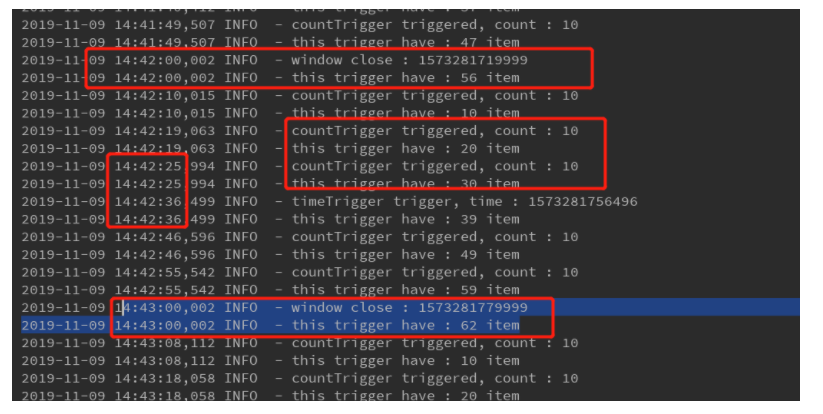来源:https://www.yht7.com/news/1924
Flink 中窗口是很重要的一个功能,而窗口又经常配合触发器一起使用。
Flink 自带的触发器大概有:
CountTrigger: 指定条数触发
ContinuousEventTimeTrigger:指定事件时间触发
ContinuousProcessingTimeTrigger:指定处理时间触发
ProcessingTimeTrigger: 默认触发器,窗口结束触发
EventTimeTrigger: 默认处理时间触发器,窗口结束触发
NeverTrigger:全局窗口触发器,不触发
但是没有可以指定时间和条数一起作为触发条件的触发器,所有就自己实现了一个(参考:ProcessingTimeTrigger、CountTrigger)
看下调用触发器的窗口代码:
val stream = env.addSource(kafkaSource) .map(s => { s }) .windowAll(TumblingProcessingTimeWindows.of(Time.seconds(60))) .trigger(CountAndTimeTrigger.of(10, Time.seconds(10))) .process(new ProcessAllWindowFunction[String, String, TimeWindow] { override def process(context: Context, elements: Iterable[String], out: Collector[String]): Unit = { var count = 0 elements.iterator.foreach(s => { count += 1 }) logger.info("this trigger have : {} item", count) } })
很简单的一段代码:定义了一个60秒的窗口,触发器是自己实现的10条数据或者 10 秒触发一次的触发器,窗口函数就输出窗口数据的条数
下面看下自定义触发器 CountAndTimeTrigger 的代码
/** * CountAndTimeTrigger : 满足一定条数和时间触发 * 条数的触发使用计数器计数 * 时间的触发,使用 flink 的 timerServer,注册触发器触发 * * @param <W> */ public class CountAndTimeTrigger<W extends Window> extends Trigger<Object, W> { private Logger logger = LoggerFactory.getLogger(this.getClass()); // 触发的条数 private final long size; // 触发的时长 private final long interval; private static final long serialVersionUID = 1L; // 条数计数器 private final ReducingStateDescriptor<Long> countStateDesc = new ReducingStateDescriptor<>("count", new ReduceSum(), LongSerializer.INSTANCE); // 时间计数器,保存下一次触发的时间 private final ReducingStateDescriptor<Long> timeStateDesc = new ReducingStateDescriptor<>("fire-interval", new ReduceMin(), LongSerializer.INSTANCE); public CountAndTimeTrigger(long size, long interval) { this.size = size; this.interval = interval; } @Override public TriggerResult onElement(Object element, long timestamp, W window, TriggerContext ctx) throws Exception { // 注册窗口结束的触发器, 不需要会自动触发 // ctx.registerProcessingTimeTimer(window.maxTimestamp()); // count ReducingState<Long> count = ctx.getPartitionedState(countStateDesc); //interval ReducingState<Long> fireTimestamp = ctx.getPartitionedState(timeStateDesc); // 每条数据 counter + 1 count.add(1L); if (count.get() >= size) { logger.info("countTrigger triggered, count : {}", count.get()); // 满足条数的触发条件,先清 0 条数计数器 count.clear(); // 满足条数时也需要清除时间的触发器,如果不是创建结束的触发器 if (fireTimestamp.get() != window.maxTimestamp()) { // logger.info("delete trigger : {}, {}", sdf.format(fireTimestamp.get()), fireTimestamp.get()); ctx.deleteProcessingTimeTimer(fireTimestamp.get()); } fireTimestamp.clear(); // fire 触发计算 return TriggerResult.FIRE; } // 触发之后,下一条数据进来才设置时间计数器注册下一次触发的时间 timestamp = ctx.getCurrentProcessingTime(); if (fireTimestamp.get() == null) { // long start = timestamp - (timestamp % interval); long nextFireTimestamp = timestamp + interval; // logger.info("register trigger : {}, {}", sdf.format(nextFireTimestamp), nextFireTimestamp); ctx.registerProcessingTimeTimer(nextFireTimestamp); fireTimestamp.add(nextFireTimestamp); } return TriggerResult.CONTINUE; } @Override public TriggerResult onProcessingTime(long time, W window, TriggerContext ctx) throws Exception { // count ReducingState<Long> count = ctx.getPartitionedState(countStateDesc); //interval ReducingState<Long> fireTimestamp = ctx.getPartitionedState(timeStateDesc); // time trigger and window end if (time == window.maxTimestamp()) { logger.info("window close : {}", time); // 窗口结束,清0条数和时间的计数器 count.clear(); ctx.deleteProcessingTimeTimer(fireTimestamp.get()); fireTimestamp.clear(); return TriggerResult.FIRE_AND_PURGE; } else if (fireTimestamp.get() != null && fireTimestamp.get().equals(time)) { logger.info("timeTrigger trigger, time : {}", time); // 时间计数器触发,清0条数和时间计数器 count.clear(); fireTimestamp.clear(); return TriggerResult.FIRE; } return TriggerResult.CONTINUE; } @Override public TriggerResult onEventTime(long time, W window, TriggerContext ctx) throws Exception { return TriggerResult.CONTINUE; } @Override public boolean canMerge() { return true; } @Override public void clear(W window, TriggerContext ctx) throws Exception { } @Override public void onMerge(Window window, OnMergeContext ctx) { ctx.mergePartitionedState(countStateDesc); ctx.mergePartitionedState(timeStateDesc); } @Override public String toString() { return "CountAndContinuousProcessingTimeTrigger( maxCount:" + size + ",interval:" + interval + ")"; } public static <W extends Window> CountAndTimeTrigger<W> of(long maxCount, Time interval) { return new CountAndTimeTrigger(maxCount, interval.toMilliseconds()); } /** * 用于合并 */ private static class ReduceSum implements ReduceFunction<Long> { private static final long serialVersionUID = 1L; @Override public Long reduce(Long value1, Long value2) { return value1 + value2; } } /** * 用于合并 */ private static class ReduceMin implements ReduceFunction<Long> { private static final long serialVersionUID = 1L; @Override public Long reduce(Long value1, Long value2) { return Math.min(value1, value2); } } }
主要是在数据进来的时候,调用 onElement 做条数的计数器,满足条件就触发, onProcessingTime 是 flink 的 timeservice 调用的,作为定时触发的触发器
在时间和条数的定时器都有清除时间和条数计数器的计数,让计数器在下一条数据到的时候,重新开始计数
特别需要注意:窗口结束的时候,会自动触发调用 onProcessingTime ,一定要包含在触发器逻辑里面,不然不能获取窗口的完整数据
// time trigger and window end if (time == window.maxTimestamp()) { logger.info("window close : {}", time); // 窗口结束,清0条数和时间的计数器 count.clear(); ctx.deleteProcessingTimeTimer(fireTimestamp.get()); fireTimestamp.clear(); return TriggerResult.FIRE_AND_PURGE; } e
如在获取到窗口触发时间是窗口的结束时间(即窗口的结束时间减1,Java的时间精度是到毫秒,如 10秒的窗口时间是:(00000, 10000)0000-10000 ,实际上窗口结束时间就是 9999)
看执行的结果:

从 “14:42:00,002 INFO - window close : 1573281719999” 窗口结束
到 “14:42:10,015 INFO - countTrigger triggered, count : 10 ” , “14:42:19,063 INFO - countTrigger triggered, count : 10” 条数触发
到 “14:42:36,499 INFO - timeTrigger trigger, time : 1573281756496” 时间触发
最后 窗口结束 “14:43:00,002 INFO - window close : 1573281779999”